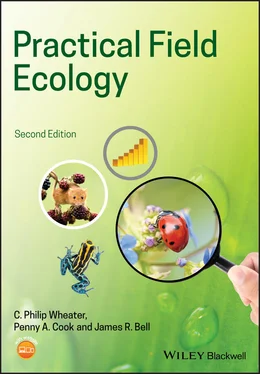 Collection of dung beetles from a baited pitfall trap ready to be sorted for identification.
Collection of dung beetles from a baited pitfall trap ready to be sorted for identification.
One major issue with pitfall trapping is obtaining an accurate relative sample of dung beetle diversity. Without adequate sampling effort, dominant species are often over‐represented and rare species may be missed entirely. Traps frequently generate large numbers of common species over a short time period, but longer trapping periods of up to one month may be needed in species‐rich tropical locations where dung beetle niches are smaller. Factors such as the quantity of moonlight, or seasonal shifts in temperature could determine if rare species are detected or not. Another common issue when using baited pitfall traps is trap disturbance by other animals. Once traps are set, they are left unattended until the observer returns. This allows inquisitive species such as hyenas ( Crocuta crocuta ), or animals such as mongooses (e.g. Mungos mungo ) which like to feed on captured beetles, ample time to disrupt trapping effort and consume valuable data.
Once trap data have been collected, the samples need to be sorted and identified to species or morphospecies. This typically requires a high‐powered microscope and access to many intricately written identification keys. Identifying dung beetles to species level requires time and tenacity, and access to existing collections to verify identifications can be beneficial. This can be challenging when collecting species internationally, but can be circumnavigated by using collections belonging local or national museums.
How the challenge was resolved
A dung beetle project's success will largely depend on the amount and length of time pitfall traps are deployed. It is recommended that a pilot study be conducted in the same location, and during the same season, for at least one entire trapping effort. Traps should be set and collected daily for a minimum of 8 days. A species accumulation curve should then be constructed. Species accumulation curves are easy to construct and are readily interpretable to give the researcher an indication of the minimum sampling effort required for an adequate inventory, which avoids incurring extra time and fieldwork costs.
Standard methods for pitfall traps usually employ dung suspended over a bucket which is placed into the ground with the lip of the bucket flush with the soil surface. One method of avoiding trap loss by other animals is to use pitfall traps with built‐in mesh enclosures. The trap is constructed from a one‐gallon sturdy container, such as a paint can with the lid placed on the container but the centre of the lid removed and replaced with strong chicken wire. This design means that even if the trap is disturbed, captured beetles remain inside the container and the sample will not be lost.
Sorting and identifying dung beetles to species can be tricky. Forging strong collaborations with scientists and museums in‐country allows access to holotype specimens found in their collections, and if export for further analyses are required these collaborations will ensure that the export process conforms with both national and international law. Roisin worked closely with National Museums Kenya in Nairobi and deposited specimens in their collection to leave a permanent record of Kenyan dung beetle diversity for future dung beetle enthusiasts.
Advice for students wanting to study dung beetles
Dung baited pitfall traps are a relatively easy and enjoyable method of assessing habitat modification and its associated effects. There are, however, health risks associated with using animal dung as bait. The handling of dung and other contaminants expose scientists to an increased risk of gastrointestinal infection, and care must be taken to minimise exposure and employ strict hygiene routines. Regular handwashing in conjunction with the use of disposable gloves are often the minimum requirements to avoid infection.
Dung beetle species richness is highest in the tropical forests and grasslands of Africa. These habitats also contain the world's highest density large wild animal populations, and an increased awareness of working in such locations is necessary to collect meaningful data safely. Studying fantastic insects such as dung beetles can be incredibly worthwhile, especially as there are still numerous new species found every year (e.g. Roggero et al. 2017).
Box 1.9 Checklist for field research planning
1 Determine the question and formulate the aims, objectives, and hypotheses.Determine whether a manipulative experiment or observational survey would be the most appropriate method to use.Decide whether you are looking primarily at the presence or absence of a species, relative abundance (e.g. counts of organisms), absolute abundance (e.g. population sizes or densities), community structures, behavioural responses, etc.Determine the statistical analyses that are likely to be employed.Select the appropriate sampling technique, taking into account the intended statistical analysis.Decide on the taxonomic level for identification, or the appropriate ecological grouping you will use (see Chapter 2).Assess what types of data will be collected and produce a standardised recording sheet.Work out the sampling design, including sample sizes.Select appropriate sample sites.Determine the site characteristics that will be monitored and choose appropriate techniques for doing this.Obtain permission to use the sites and check any legal restrictions.Carefully consider the ethical implications of the study.Risk assess all the work to be carried out.Employ a pilot study and amend your protocol if necessary.
1 1 http://naturenet.net/orgs
2 2 http://jncc.defra.gov.uk/page-1375
3 3 http://www.cell.com/trends/ecology-evolution/home
4 4 https://www.software4conservation.com
5 5 http://jncc.defra.gov.uk/page-4592
6 6 https://nbn.org.uk
7 7 http://endnote.com
8 8 https://www.mendeley.com
9 9 https://www.zotero.org
10 10 https://www.epa.gov/laws-regulations/summary-endangered-species-act
11 11 http://ec.europa.eu/environment/nature/legislation/birdsdirective/index_en.htm
12 12It is important to ensure that any changes to such acts are taken on board; for example, amendments to the Wildlife and Countryside Act 1981 can be found at www.legislation.gov.uk/ukpga/1981/69
13 13 www.hse.gov.uk/coshh
14 14 www.usha.org.ukor https://uceastorage.blob.core.windows.net/ucea/download.cfm/docid/responsible_research_-_managing_h_s_in_research.pdf
15 15 http://www.nhs.uk/Conditions/Leptospirosis/Pages/Introduction.aspx
16 16 http://www.nhs.uk/Conditions/Lyme-disease/Pages/Introduction.aspx
17 17 https://www.gov.uk/government/publications/algal-blooms-advice-for-the-public-and-landowners/algal-blooms-advice-for-the-public-and-landowners
18 18 https://www.fitfortravel.nhs.uk/advice/malaria/mosquito-bite-avoidance
19 19 http://www.nhs.uk/chq/Pages/1072.aspx?CategoryID=67
20 20 https://www.vaccines.gov/who_and_when/travel
21 21 https://www.rgs.org/in-the-field
22 22 https://www.gov.uk/foreign-travel-advice
23 23 www.brc.ac.uk/record-cards
24 24 http://www.bto.org/bbs/take_part/download-forms.htm
25 25For example, Rollin Brant at the University of British Columbia (http://www.stat.ubc.ca/∼rollin/stats/ssize/index.html ) and the Australian National Statistical Service ( http://abs.gov.au/websitedbs/D3310114.nsf/home/Sample+Size+Calculator). In order to access sample size calculations in R see http://www.statmethods.net/stats/power.html
Читать дальше

 Collection of dung beetles from a baited pitfall trap ready to be sorted for identification.
Collection of dung beetles from a baited pitfall trap ready to be sorted for identification.










